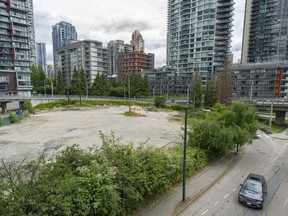Public responses so far run counter to development by those concerned about unserviced density and an urban planning professor says density can be achieved without building towers that dominate areas of Vancouver.

article content
Vancouver is proposing a new development of six residential towers with condominiums, rentals and social housing totaling nearly a million square feet at the north end of the Granville Street Bridge, a plan that is drawing mixed reviews from residents and urban planners.
Announcement 2
article content
The city’s general manager of planning and urban design recommends that the city council submit a rezoning application for the land between Seymour and Howe streets along Pacific Boulevard for a public hearing.
The land is currently occupied by the former Black Top Cabs office to the west and the Continental SRO hotel to the east. It would have to be rezoned to allow construction of two 40-story towers of market condominiums, two 27-story towers and two 12-story towers of mixed condominiums, rentals and social housing, according to a city report.
- Vancouver is proposing a large condominium rental social housing development at the north end of the Granville Bridge. Artist renderings provided by the City of Vancouver.
The buildings, which would include a child care center and retail and commercial space, would be built where traffic loops now connect bridge traffic to Pacific Street. The decision to tear down the loops was approved by the city five years ago.
Announcement 3
article content
Of the 134 public responses to the city’s online comment platform collected from January 4 to October 7, 2021, 85 were opposed, 33 were supportive, and 20 were mixed.
Opponents were concerned about mass and density (including lack of adequate setbacks), building height (including loss of views and shadows), noise and disruption, amount of social housing in an area with “too much” social housing, increased traffic, lack of schools and kindergartens, and the elimination of loops, according to the report.
Those in favor said that more rental and social housing is needed, that mass and density are welcome, and that the development was appropriate for the area, but that they would like to see more parks, services, retail, and walking trails. pedestrians and bicycles.
Announcement 4
article content
One urban planning expert told Postmedia that Vancouver is stuck on building towers rather than exploring “medium density” options that work elsewhere, while another said the plan doesn’t include enough affordable rental units.
Building towers achieve density, but there are other ways to densify neighborhoods that would improve a city’s livability, said UBC’s Michael Hooper, an associate professor in the school of community and regional planning.
“Vancouver’s approach to density has been to build towers,” he said. “There is a feeling that density is seen a certain way, with tall towers, and if people don’t like towers, they don’t like density. That’s a simplistic way of looking at density, and a particular Vancouver simplicity.”
ad 5
article content
What Vancouver could be exploring or experimenting with are urban plans that include a larger number of smaller towers spread over a larger area to achieve the same amount of density, he said.
- Vancouver is proposing a large condominium rental social housing development at the north end of the Granville Bridge. Artist renderings provided by the City of Vancouver.
Vancouver has more residential skyscrapers than any other city in North America, according to skyscrapercentre.comwith more than 650 buildings with more than 10 floors and 50 with more than 32 floors.
Hooper said that concentrating tall towers in a city center or area but allowing lower density elsewhere doesn’t necessarily translate to overall high density. For example, he said that Los Angeles has better density than New York City because LA has “vast swathes of medium-density buildings” throughout the city.
ad 6
article content
He said four- to six-story medium-density buildings in a wider area than just along arterials can create livable neighborhoods, citing Westbrook Village on the UBC campus as an example.
“Vancouver doesn’t do well with medium density,” he said.
“In Vancouver, the simplistic focus on housing units alone presents a challenge” if cities don’t provide the necessary amenities for “good density” such as community centers and schools, he said.
UBC professor Patrick Condon, the James Taylor chair in landscape and living environments, said in an email that Vancouver is “ignoring the success of the Olympic Village form of housing that derives high density from a ‘building with buildings’ typology. patio’ of medium height. ”
He said cities should “insist on a minimum of 50 percent noncommercial affordable housing units, linked to 30 percent of median household income or less, as a condition of approving any density increases along the Broadway corridor.” , and said the same should apply to the proposed development of the Granville Bridge.
ad 7
article content
The proposal includes about 606,000 square feet, or about two-thirds of the total, for strata-titled condominiums, while about 126,000 square feet are designated for market rental units and about 160,000 square feet are designated for the 109 social housing units (to replace the same number of SROs lost when the Continental closed).
-
Douglas Todd: Metro Vancouver has 650 homes worth more than $10 million. That is 13 times higher than in 2010
-
Douglas Todd: The Hidden Climate Costs of BC’s Burgeoning Skyscrapers, Part II
-
Douglas Todd: Canada’s real estate market has turned around. Here are 5 things you should know
-
Canada needs 3.5 million more homes than planned to restore affordability, says CMHC
More news, less ads: Our in-depth journalism is possible thanks to the support of our subscribers. For just $3.50 a week, you can get unlimited, ad-lite access to The Vancouver Sun, The Province, National Post, and 13 other Canadian news sites. Support us by subscribing today: The Vancouver Sun | The province.





